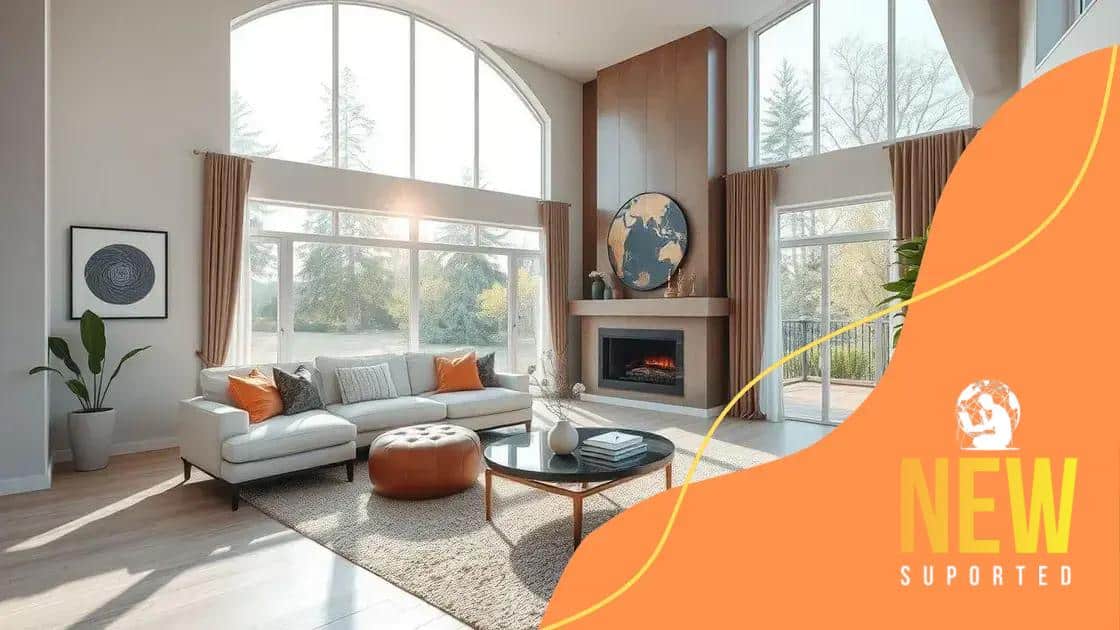How to design a home for maximum natural light

To design a home for maximum natural light, assess your space, choose appropriate windows and doors, integrate reflective surfaces, use light colors, and landscape wisely to enhance sunlight exposure.
How to design a home for maximum natural light can truly change your living environment, making it more vibrant and uplifting. Have you ever imagined walking into a space filled with sunlight? Let’s dive into the details that can help you achieve this dream.
Assessing your space for natural light
Assessing your space for natural light is a crucial first step towards creating a bright and inviting home. Start by examining which areas of your home receive the most sunlight throughout the day. Consider both the orientation of your house and the presence of any nearby trees or buildings that might obstruct light.
Each room can have unique characteristics that affect light exposure. For example, north-facing rooms typically get softer light, while south-facing ones enjoy sunshine all day. Note where your windows are located and how their size affects light entry. This will help you enhance your design.
Evaluate Room Size and Layout
The size and layout of your rooms play significant roles in the amount of natural light they receive. Larger rooms with open layouts allow light to flow more easily. Additionally, the placement of mirrors can reflect light and brighten darker corners. When assessing, think about:
- Room dimensions and ceiling height
- Window size and design
- Color of the walls and furniture
Next, don’t forget to consider how daylight changes throughout the seasons. For instance, winter sunlight is lower in the sky, allowing different areas to be illuminated compared to summer. Make observations at different times of the day and year to get a clear picture.
Identify Obstacles to Natural Light
It’s essential to identify any obstacles that may limit light. Tall shrubs, overhanging branches, or even architectural features can block sunlight. Use the assessment of your surroundings to make informed design choices. If needed, consider landscaping changes that can enhance light reaching your windows.
In summary, thorough evaluation is key to maximizing natural light in your home. Assessing every aspect, from room orientation to obstacles, will help you design a radiant space.
Choosing the right windows and doors
Choosing the right windows and doors is essential for maximizing natural light in your home. The design and placement of these features can have a significant impact on how sunlight enters your space. Consider options that not only enhance aesthetics but also improve energy efficiency.
Types of Windows
There are many types of windows available, each serving different purposes. For instance, casement windows swing open and are great for ventilation. Double-hung windows allow for airflow while maintaining traditional style. Picture windows are ideal for unobstructed views and capturing maximum light.
- Casement windows for ventilation
- Double-hung windows for classic style
- Picture windows for larger views
Another option is skylights. Installing skylights can drastically increase light in ceilings that would otherwise be dark. They are particularly effective in bathrooms and kitchens.
Choosing Doors for Light
When selecting doors, consider options with glass panels or French doors that open up spaces while allowing light to flow through. Sliding glass doors are popular choices for creating a seamless connection between indoor and outdoor areas.
Additionally, the frame color and material can influence light reflection. Light-colored frames reflect more light into your home, enhancing brightness.
Always evaluate the size and orientation of your doors and windows. Larger openings facing south or west will capture the most sunlight. Use this information to create an inviting, well-lit environment.
Integrating reflective surfaces

Integrating reflective surfaces into your home design can significantly enhance the natural light that enters your space. Reflective materials, such as glass, mirrors, and shiny finishes, help bounce light around, making rooms feel brighter and more spacious.
Types of Reflective Surfaces
There are various types of reflective surfaces you can use. Mirrors are a classic option, and placing them strategically can create a stunning effect. For instance, a large mirror across from a window will reflect sunlight and brighten the entire room.
- Mirrors for increased light and space illusion
- Glossy tiles in kitchens and bathrooms to reflect light
- Glass furniture to enhance brightness
In addition to mirrors, consider using materials with a high gloss finish for your furniture and cabinetry. This not only adds elegance but also improves the overall lighting effect in your home. Glossy paint can also brighten your walls, reflecting light and adding a sense of airiness.
Positioning and Layout
The positioning of these reflective surfaces matters. For example, placing a mirror opposite a window creates a captivating view that enhances natural light. You can also arrange reflective surfaces around dark corners to minimize shadows.
Additionally, using reflective surfaces in tandem with large windows and doors can amplify the sunlight entering your rooms. This layered approach to light can help you create a well-lit, welcoming atmosphere.
Using colors that amplify light
Using colors that amplify light is a powerful way to enhance the brightness and warmth of your home. Light colors reflect more sunlight, making spaces feel airier and larger. If you’re looking to create a sunlit environment, consider your color choices carefully.
Choosing the Right Paint Colors
When selecting paint colors, opt for shades like whites, creams, and pastels that reflect light. Light hues tend to bounce light around the room, whereas darker shades can absorb it. Neutral tones create a calm background that complements natural light.
- Soft whites for a clean, fresh look
- Pale blues to evoke tranquility
- Light yellows to add warmth and cheerfulness
Consider also how your wall colors interact with natural light at different times of day. As the light changes, the hues can appear differently. Test samples in various lighting conditions to find the best shade for your space.
Incorporating Accents
Accents play a crucial role in amplifying light. Use light-colored furniture and accessories to enhance the effect. A light sofa or bright cushions can make a significant difference in how light is perceived. You might also want to add reflective elements, such as metallic accessories, to further increase brightness.
Another tip is to use vibrant or lighter-colored rugs to tie a room together while enhancing the lightness of the overall design. The right accessories can make your space feel well-lit and cheerful.
Landscaping to enhance sunlight exposure
Landscaping to enhance sunlight exposure is a vital aspect of creating a home filled with natural light. The way you design your outdoor space can significantly influence how much sunlight reaches your windows and, ultimately, your interior.
Understanding Shade Patterns
Start by observing the shade patterns created by trees, shrubs, and structures around your home. Tall trees can block valuable sunlight, especially during the afternoon. It’s essential to know which areas receive the most light and where shadows fall.
- Identify large trees that may require trimming or relocation.
- Choose smaller plants that won’t overshadow windows.
- Consider flowering plants that thrive in sunny spots to create bright visuals.
Incorporating native plants can also be beneficial. They often require less maintenance and thrive better in local climates, which means they are more likely to grow well in sunlit areas. Ensure that your chosen plants complement the light they will receive throughout the day.
Using Hardscapes Wisely
In addition to plants, think about the hardscapes in your yard. Patios, pathways, and decks can reflect sunlight and help to distribute light around your home. Use materials that have light or reflective surfaces to enhance this effect.
Installing trellises or pergolas can provide structure while allowing sunlight to filter through. This combination adds beauty and functionality, creating shaded areas without completely blocking light from entering your home.
Remember, good landscaping not only enhances your property’s aesthetic appeal but also improves the quality of light inside. A well-planned outdoor space can increase sunlight exposure and create a brighter, more inviting home.
FAQ – Questions about designing a home for maximum natural light
What are some key strategies for maximizing natural light in a home?
Key strategies include assessing your space, choosing appropriate windows and doors, integrating reflective surfaces, using bright colors, and landscaping to enhance sunlight exposure.
How can I evaluate which areas of my home receive the most light?
Observe the sunlight patterns throughout the day and take note of which rooms are brighter during different times to assess light exposure.
What types of windows are best for increasing natural light?
Casement, double-hung, and picture windows are great options, as they allow in more light. Using larger windows or skylights can also make a significant difference.
How does landscaping impact sunlight in my home?
Proper landscaping can minimize shade from trees and shrubs, allowing more sunlight to reach your windows. Choosing smaller plants or adjusting the layout can improve exposure.






